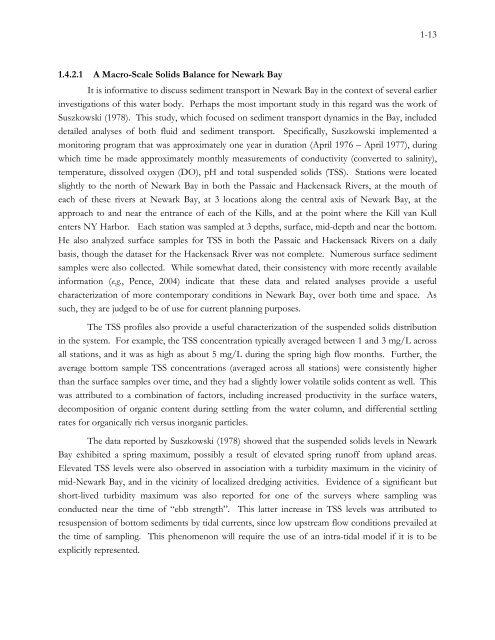Newark Bay Study - Passaic River Public Digital Library
Newark Bay Study - Passaic River Public Digital Library
Newark Bay Study - Passaic River Public Digital Library
Create successful ePaper yourself
Turn your PDF publications into a flip-book with our unique Google optimized e-Paper software.
1.4.2.1 A Macro-Scale Solids Balance for <strong>Newark</strong> <strong>Bay</strong><br />
1-13<br />
It is informative to discuss sediment transport in <strong>Newark</strong> <strong>Bay</strong> in the context of several earlier<br />
investigations of this water body. Perhaps the most important study in this regard was the work of<br />
Suszkowski (1978). This study, which focused on sediment transport dynamics in the <strong>Bay</strong>, included<br />
detailed analyses of both fluid and sediment transport. Specifically, Suszkowski implemented a<br />
monitoring program that was approximately one year in duration (April 1976 – April 1977), during<br />
which time he made approximately monthly measurements of conductivity (converted to salinity),<br />
temperature, dissolved oxygen (DO), pH and total suspended solids (TSS). Stations were located<br />
slightly to the north of <strong>Newark</strong> <strong>Bay</strong> in both the <strong>Passaic</strong> and Hackensack <strong>River</strong>s, at the mouth of<br />
each of these rivers at <strong>Newark</strong> <strong>Bay</strong>, at 3 locations along the central axis of <strong>Newark</strong> <strong>Bay</strong>, at the<br />
approach to and near the entrance of each of the Kills, and at the point where the Kill van Kull<br />
enters NY Harbor. Each station was sampled at 3 depths, surface, mid-depth and near the bottom.<br />
He also analyzed surface samples for TSS in both the <strong>Passaic</strong> and Hackensack <strong>River</strong>s on a daily<br />
basis, though the dataset for the Hackensack <strong>River</strong> was not complete. Numerous surface sediment<br />
samples were also collected. While somewhat dated, their consistency with more recently available<br />
information (e.g., Pence, 2004) indicate that these data and related analyses provide a useful<br />
characterization of more contemporary conditions in <strong>Newark</strong> <strong>Bay</strong>, over both time and space. As<br />
such, they are judged to be of use for current planning purposes.<br />
The TSS profiles also provide a useful characterization of the suspended solids distribution<br />
in the system. For example, the TSS concentration typically averaged between 1 and 3 mg/L across<br />
all stations, and it was as high as about 5 mg/L during the spring high flow months. Further, the<br />
average bottom sample TSS concentrations (averaged across all stations) were consistently higher<br />
than the surface samples over time, and they had a slightly lower volatile solids content as well. This<br />
was attributed to a combination of factors, including increased productivity in the surface waters,<br />
decomposition of organic content during settling from the water column, and differential settling<br />
rates for organically rich versus inorganic particles.<br />
The data reported by Suszkowski (1978) showed that the suspended solids levels in <strong>Newark</strong><br />
<strong>Bay</strong> exhibited a spring maximum, possibly a result of elevated spring runoff from upland areas.<br />
Elevated TSS levels were also observed in association with a turbidity maximum in the vicinity of<br />
mid-<strong>Newark</strong> <strong>Bay</strong>, and in the vicinity of localized dredging activities. Evidence of a significant but<br />
short-lived turbidity maximum was also reported for one of the surveys where sampling was<br />
conducted near the time of “ebb strength”. This latter increase in TSS levels was attributed to<br />
resuspension of bottom sediments by tidal currents, since low upstream flow conditions prevailed at<br />
the time of sampling. This phenomenon will require the use of an intra-tidal model if it is to be<br />
explicitly represented.




